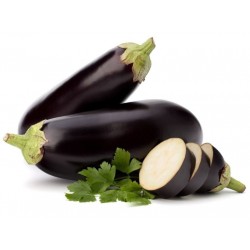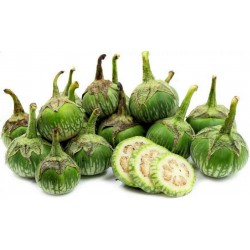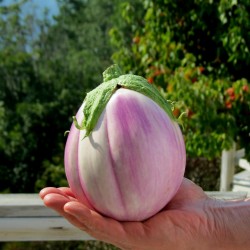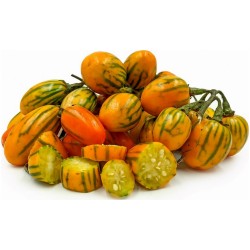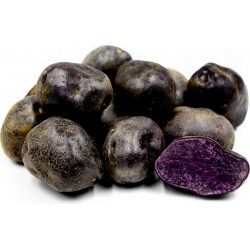Seeds Gallery EU,
5/
5
<!DOCTYPE html>
<html>
<head>
<meta http-equiv="Content-Type" content="text/html; charset=UTF-8" />
</head>
<body>
<h2><strong>Seme Crvenog Krompira KENNEBEC</strong></h2>
<h2><span style="color: #ff0000;"><strong>Cena je za pakovanje od 10 semena.</strong></span></h2>
<p>Razlika u gajenju izmedju pravog semena koje se nalazi u malim plodovima nalik paradajzu I semenskog krompira je ta sto kada gajite krompir iz pravog semena ne napadaju ga zlatice I ostale stetocine toliko kao kada sadite semenski krompir. Mi vam ovde nudimo pravo seme a ne semenski krompir stare sorte crvenog krompira koji ima odlican ukus I naradje se koristi za pravljenje pomfrita I uopste pecenje.</p>
<p><strong>Probajte I uverite se sami u kvalitet I ukus ove sorte…</strong></p>
<p><strong>Takodje vam zelimo najaviti i seme PLAVOG - LJUBICASTOG krompira...<br /></strong></p>
<p>Start indoors in seedling trays. Fill each cell to 1cm (1/2") from the top with sterilized seed starting mix. Moisten with water and place one seed on the top of the soil per cell. Cover with vermiculite and water in. Note: Potato seeds require light to germinate, so do not bury. Optimal soil temperature for germination: 15-27°C (65-80°F). Seeds should germinate in 6-10 days.</p>
<p><strong>Starting</strong><br />Keep the soil evenly moist during germination, but allow free drainage so that excess water does not collect. Water before mid-day to allow foliage to dry completely by nightfall. Potato seedlings <span>tend to stay prostrate immediately after emergence if they have 13 or more hours of daylight. As a somewhat longer stem is desired to ease transplanting, keep seedlings in about 12-hour light per day. During the last week expose seedlings to full sunlight to strengthen the stem. At optimal temperature, transplants will be ready 4 to 6 weeks after seeding.</span></p>
<p><span>If field conditions are very different from indoor conditions, allow one week of hardening off. Water the plugs heavily the day before and day of transplant, and transplant into moist soil.</span></p>
<p><strong>Growing</strong><br />Ideal pH: 5.0-6.0. Plant seedlings so that only the crown of its top, 2-5cm (1-2“) is above soil level, burying the whole plug and a good part of the stem of the seedling. Seedlings cannot be completely buried, the growing point needs to stay above ground. Space seedlings 10-25cm (4-10") apart in rows 75cm (30") apart. Wider spacing produces fewer, but larger tubers. Keep the area well watered for several weeks after transplant.</p>
<p><strong>Hilling<br /></strong><span>When seedlings reach 10-15cm (4-6") in height, they should be hilled, probably three weeks after transplanting. This operation takes soil from the centre of the row, and covers the seedlings up to half of their height, creating a small hill. It is best to work from the centre of the furrow towards the plants. Do not cut too deep into the soil near the plant to avoid root damage. Just before hilling, fertilizer can be applied near the base of the seedlings, and this will be covered when hilling.</span></p>
<p>A second hilling and side dressing of balanced organic fertilizer should follow 3-4 weeks after the first, again depositing soil up to half the height of the plants. Again, increase the depth of the furrow in its centre and bring this soil on top of the small hill created in the first hilling operation.</p>
<p><strong>Harvest</strong></p>
<p><span>In the garden, potatoes can be harvested without destroying the plant if only a few potatoes are needed. Carefully scrape soil near the base of the stem until the skin of a potato is found, and pull it from the stolon. Consume it that day for a tasty and nutritious meal. </span>If potatoes need to be stored for some time, remove the foliage 3 weeks before harvest. This "sets" (hardens) the skin, and it will store better as the thicker skin will reduce water loss from the tubers. Keep them dark up to 2 to 3 months at high humidity before eating.</p>
<p><strong>Seed Info</strong><br />In optimal conditions, at least 75% of the seeds will germinate. Usual seed life: 3 years. Per 100′ row: 200 seeds, per acre: 8.8M seeds.</p>
<p><strong>Diseases & Pests</strong><br />Protect from cabbage moths and other insect pests with floating row cover. Prevent disease with a strict 4-year crop rotation, avoiding planting Brassicas in the same spot more than once every four years.</p>
<p><strong>Companion Planting</strong><br />A worthy companion for beets, Brassicas, cucumbers, and onions. Avoid planting near peppers, pole beans, strawberries, and tomatoes.</p>
</body>
</html>
P 247 RK

